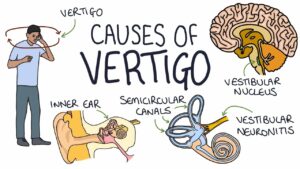
Have you ever felt like the world around you is spinning out of control, even when you’re perfectly still? Welcome to the enigmatic world of vertigo. Vertigo, often misunderstood as a fear of heights, is a complex neurological condition that disrupts our sense of balance and spatial orientation. In this article, we delve into the depths of vertigo, exploring its causes, treatments, precautions, and the role of neuroscience in unraveling its mysteries.
Causes of Vertigo

- Inner Ear Disorders:
The inner ear comprises delicate structures crucial for balance, including the semicircular canals and the cochlea. Disorders affecting the inner ear, such as Meniere’s disease, disrupt the normal fluid balance within these structures, leading to vertigo episodes. Meniere’s disease is characterized by fluid build-up in the inner ear, causing pressure changes that result in vertigo, hearing loss, and tinnitus. Vestibular neuritis, another inner ear disorder, involves inflammation of the vestibular nerve, often triggered by viral infections. This inflammation disrupts the transmission of balance signals to the brain, resulting in vertigo spells.
- Benign Paroxysmal Positional Vertigo (BPPV)
BPPV is the most common form of vertigo, typically triggered by specific head movements. Within the inner ear’s semicircular canals, tiny calcium carbonate crystals called otoliths or canaliths can become dislodged and accumulate in the wrong part of the canal. These displaced crystals interfere with the normal flow of fluid within the semicircular canals, sending false signals to the brain about head movement, leading to vertigo spells.
- Neurological Issues
Vertigo can also stem from neurological conditions affecting the brain and its associated structures. Migraines, for instance, can cause vertigo as a symptom, often referred to as vestibular migraines. These migraines may involve abnormal activity in the brain’s vestibular pathways, leading to vertigo episodes. More severe neurological issues such as strokes or tumors affecting the brainstem or cerebellum can disrupt the brain’s ability to process balance signals, resulting in vertigo.
- Medication Side Effects
Certain medications, particularly those affecting the inner ear or the brain’s neurotransmitter levels, can induce vertigo as a side effect. Examples include certain antibiotics, antiepileptic drugs, antidepressants, and medications used to treat high blood pressure. These medications can interfere with the normal functioning of the vestibular system or disrupt the brain’s ability to process balance signals, leading to vertigo symptoms.
Treatment Options
- Vestibular Rehabilitation Therapy (VRT)
VRT is a structured program administered by trained therapists to address vertigo and balance issues. It involves exercises tailored to each patient’s specific needs, focusing on enhancing the brain’s ability to compensate for vestibular deficits. These exercises may include head movements, eye exercises, balance training, and habituation exercises aimed at desensitizing the vestibular system to motion-related stimuli. VRT aims to improve balance, reduce dizziness and vertigo symptoms, and enhance overall quality of life for individuals affected by vestibular disorders.
- Canalith Repositioning Maneuvers
Canalith repositioning maneuvers, such as the Epley maneuver or the Semont maneuver, are highly effective treatments for benign paroxysmal positional vertigo (BPPV). These maneuvers involve specific head and body movements designed to reposition displaced calcium crystals (canaliths) within the inner ear’s semicircular canals. By guiding the movement of these particles back to their proper location, canalith repositioning maneuvers alleviate vertigo symptoms and restore normal vestibular function. These maneuvers are often performed by healthcare professionals but can also be taught for self-administration at home under proper guidance.
- Medications
Medications may be prescribed to manage vertigo symptoms or address underlying causes, depending on the individual’s diagnosis and medical history. Antihistamines such as meclizine or diphenhydramine can help alleviate vertigo and associated nausea by stabilizing the vestibular system. Antiemetics like promethazine or ondansetron may be prescribed to relieve nausea and vomiting accompanying vertigo episodes. Benzodiazepines such as diazepam or lorazepam may be used to reduce anxiety associated with vertigo or to suppress vestibular symptoms.
- Surgery
Surgical intervention is typically considered when other treatments have failed to provide relief or in cases of severe vertigo due to structural abnormalities or tumors. Surgical procedures may involve repairing inner ear structures, removing tumors compressing the vestibular nerve, or severing the nerve to alleviate vertigo symptoms.
While surgery carries risks and is usually reserved as a last resort, it can be beneficial for patients with debilitating vertigo unresponsive to conservative treatments.
Precautions and Lifestyle Adjustments
- Avoid Triggers
Vertigo triggers vary from person to person but commonly include sudden head movements, rapid changes in position, and environments with excessive visual or motion stimuli. Individuals experiencing vertigo should identify their specific triggers and take proactive measures to avoid or minimize exposure to them. This may involve modifying daily activities, such as avoiding rapid head turns or crowded, visually stimulating spaces, to reduce the likelihood of vertigo episodes.
- Stay Hydrated
Adequate hydration is crucial for overall health and can also help mitigate vertigo symptoms. Dehydration can disrupt the balance of electrolytes in the body, affecting the function of the inner ear and exacerbating vertigo. Individuals prone to vertigo should ensure they drink enough water throughout the day to maintain proper hydration levels and support vestibular function.
- Mindful Movement
During vertigo episodes or when feeling dizzy, it’s essential to move cautiously and mindfully to prevent falls or injuries. Rapid movements, sudden changes in position, or standing up too quickly can trigger or worsen vertigo symptoms. Practicing deliberate and controlled movements, such as rising from a seated position slowly or using handrails for stability, can help minimize dizziness and reduce the risk of accidents.
- Stress Management
Stress and anxiety can exacerbate vertigo symptoms by heightening sensitivity to sensory inputs and increasing muscle tension. Implementing stress management techniques, such as deep breathing exercises, progressive muscle relaxation, or mindfulness meditation, can help alleviate anxiety and promote relaxation. By reducing stress levels, individuals may experience a decrease in the frequency or intensity of vertigo episodes and better cope with the challenges associated with this condition.
The Role of Neuroscience
- Understanding the Vestibular System
The vestibular system, located within the inner ear, is responsible for maintaining balance, spatial orientation, and coordination of head and eye movements. Neuroscience plays a crucial role in elucidating the complex neural pathways and sensory integration mechanisms involved in processing vestibular information. Researchers explore how signals from the vestibular organs are transmitted to the brainstem and cerebellum, where they are integrated with visual and proprioceptive inputs to maintain equilibrium.
- Advanced Imaging Techniques
Neuroscientists employ various imaging modalities, such as functional magnetic resonance imaging (fMRI), positron emission tomography (PET), and diffusion tensor imaging (DTI), to visualize brain structures and activity associated with vertigo. These techniques allow researchers to map brain regions involved in vestibular processing, identify abnormalities in patients with vertigo, and monitor changes in neural activity following treatment interventions.
- Neurophysiological Studies
Electrophysiological studies, including electroencephalography (EEG), vestibular evoked myogenic potentials (VEMP), and electronystagmography (ENG), provide valuable insights into the electrical activity of the vestibular system and its connections with other brain regions. By recording neural responses to vestibular stimuli, researchers can investigate sensory processing deficits in individuals with vertigo and develop targeted therapeutic approaches to address these impairments.
- Research in Leading Journals
Scientific journals like Nature Neuroscience serve as prominent platforms for publishing cutting-edge research on the neurobiology of vertigo. Studies published in these journals elucidate the molecular, cellular, and circuit-level mechanisms underlying vestibular function and dysfunction. By disseminating groundbreaking discoveries and fostering collaboration among researchers and clinicians, these journals drive innovation and facilitate the translation of basic science findings into clinical applications.
Vertigo may disrupt our sense of equilibrium, but with the combined efforts of medical science, physical therapy, and a deeper understanding of the neurological mechanisms at play, we can regain our balance and navigate life’s whirlwinds with confidence. By shedding light on the causes, treatments, and precautions associated with vertigo, we empower individuals to take control of their health and seek appropriate care when needed. Let’s continue to explore the fascinating intersection of neuroscience and vertigo, unlocking new insights and forging pathways towards a world where dizziness no longer holds us back from experiencing life to the fullest.








0 comments on “Navigating the Whirlwind: Understanding Vertigo and Finding Balance”